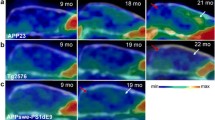Abstract
In the search for a cure for Alzheimer’s disease (AD), efforts have been focused on preventing or reversing amyloid deposition in the brain. Efficacy evaluation of these antimyloid therapies would greatly benefit from development of a tool for the in vivo detection and quantitation of amyloid deposits in the brain. Toward this goal, we have developed a series of benzothiazole derivatives as amyloid-imaging agents for positron emission tomography (PET). To extend the potential of these amyloid-imaging agents for routine clinical studies, we also set out to develop iodinated benzothiazole derivatives that could be used as dual agents for either PET or the complementary single photon emission computed tomography (SPECT). Such dual agents would permit PET or SPECT studies using radiotracers with the same chemical identity but labeled with different radionuclides. This would facilitate the validation of clinical SPECT studies, based on quantitative PET studies. In this work we report the synthesis and biological evaluation of a potent, selective, and brain-permeable benzothiazole compound, 2-(3′-iodo-4′-methylaminophenyl)-6-hydroxy-benzothialzole, termed 6-OH-BTA-1-3′-I (4), which can be radiolabeled with either positron-emitting carbon-11 or single photon-emitting iodine-125/iodine-123. The synthesis and radiolabeling of [125I]4 or [11C]4 were achieved through direct iodination with sodium [125I]iodide in the presence of chloramine T or through radiomethylation with [11C]CH3I. In vitro amyloid binding assays indicated that [125I]4 bound to amyloid deposits in a saturable manner and exhibited affinities in the nanomolar concentration range. Binding studies of [125I]4 to postmortem human brain homogenates also showed preference of binding to frontal cortex in the AD homogenates relative to age-matched control homogenates or cerebellum from either AD or control. In vivo pharmacokinetic studies in normal mice following iv injection of [11C]4 indicated that the radioligand entered the brain readily at early time points and cleared from the brain rapidly at later time points with a 2- to 30-min ratio >3. These results suggest that the new radioiodinated benzothiazole ligand might be useful as a surrogate marker for the in vivo quantitation of mayloid deposition in human brain for use with either PET or SPECT.
Similar content being viewed by others
References
Asenbaum S. (2003) PET and SPECT investigations in Alzheimer’s disease. Radiology 43, 521–530.
Hansch C. and Leo A. (1979) Substituent Constants for Correlation Analysis in Chemistry and Biology, John Wiley, New York, NY.
Herholz K., Schopphoff H., Schmidt M., Mielke R., Eschner W., et al. (2002) Direct comparison of spatially normalized PET and SPECT scans in Alzheimer’s disease. J. Nucl. Med. 43, 21–26.
Klunk W. E., Engler H., Nordberg A., Wang Y., Blomqvist G., et al. (2004) Imaging brain amyloid in Alzheimer’s disease using the novel PET tracer, PIB. Ann. Neurol. 55, 306–319.
Klunk W. E., Wang Y. M., Hung G. F., Debnah M. L., Holt D. P., et al. (2001) Uncharged thioflavin-T derivative bind to amyloid-beta protein with high affinity and readily enter the brain. Life Sci. 69, 1471–1484.
Klunk W. E., Wang Y., Huang G. F., Debnath M. L., Holt D. P., et al. (2003) The binding of 2-(4′-methyl-aminophenyl)benzothiazole to postmortem brain homogenates is dominated by the amyloid component. J. Neurosci. 23, 2086–2092.
Kung M. P., Hou C., Zhuang Z. P., Zhang B., Skovronsky D., et al. (2002) IMPY: an improved thioflavin-T derivative for in vivo labeling of beta-amyloid plaques. Brain Res. 956, 202–210.
Kung M. P., Skovronsky D. M., Hou C., Zhuang Z. P., Gur T. L., et al. (2003) Detection of amyloid plaques by radioligands for Abeta40 and Abeta42: potential imaging agents in Alzheimer’s patients. J. Mol. Neurosci. 20, 15–24.
Mathis C. A., Bacskai B. J., Kajdasz S. T., McLellan M. E., Frosch M. P., et al. (2002) A lipophilic thioflavin-T derivative for positron emission tomography (PET) imaging of amyloid in brain. Bioorg. Med. Chem. Lett. 12, 295–298.
Mathis C. A., Wang Y., and Klunk W. E. (2004) Imaging amyloid plaques and neurofibrillary tangles in the aging human brain. Curr. Pharm. Design, 10, 1469–1492.
Mathis C. A., Wang Y., Holt D. P., Huang G. F., Debnath M. L., et al. (2003) Synthesis and evaluation of 11C-labeled 6-substituted 2-arylbenzothiazoles as amyloid imaging agents. J. Med. Chem. 46, 2740–2754.
Styren S. D., Hamilton R. L., Styren G. C., and Klunk W. E. (2000) X-34, a fluorescent derivative of Congo red: a novel histochemical stain for Alzheimer’ disease pathology. J. Histochem. Cytochem. 48, 1223–1232.
Wang Y., Klunk W. E., Huang G. F., Debnath M. L., Holt D. P., et al. (2002) Synthesis and evaluation of 2-(3′-iod-4′-aminophenyl)-6-hydroxybenzothiazole for in vivo quantitation of amyloid deposits in Alzheimer’s disease. J. Mol. Neurosci. 19, 11–16.
Wang Y., Mathis C. A., Huang G.- F., Debnah M. L., Holt D., et al. (2003) Effects of lipophilicity on the affinity and non-specific binding of iodinated benzothiazole derivatives. J. Mol. Neurosci. 20, 255–260.
Author information
Authors and Affiliations
Corresponding author
Rights and permissions
About this article
Cite this article
Wang, Y., Klunk, W.E., Debnath, M.L. et al. Development of a PET/SPECT agent for amyloid imaging in Alzheimer’s disease. J Mol Neurosci 24, 55–62 (2004). https://doi.org/10.1385/JMN:24:1:055
Issue Date:
DOI: https://doi.org/10.1385/JMN:24:1:055




